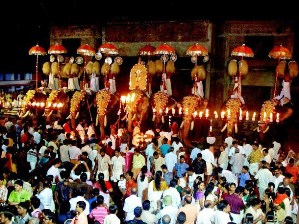Pooja Timing
The temple opens at 3 a. m in the morning and remains open till 12 p.m. The temple reopens at 4.30 p.m in the evening and remains open till 8.30 p. m.
There are five poojas conducted here as in all great temples
- usha pooja
- ethirtha pooja
- panthiradi pooja
- ucha pooja
- athazha pooja
There are three sheevelis (a processional image of the deity is carried around the temple)
- usha sheeveli
- ucha sheeveli
- athazha sheeveli
For Ucha sheeveli, elephents are not used for procession. In Mandalakalam (November-December) there will be a Kazcha Sheeveli instead of Ucha sheeveli.
Nirmalya darshan (early morning when the sanctum opens for the day) and athazha pooja are considered very sacred. For athazha pooja especially devas and rishis are supposed to be present to have darshan of the Lord.
Festivals
 The Pooram festival celebrated in the month of Meenam (March/April) and the Ekadasi celebrations in the month of Vrishchikam (November/December) are the most popular celebrations at the temple. As part of the Ekadasi celebrations, Lord Rama is taken in a royal procession accompanied by 21 elephants. This grand event attracts thousands of devotees.
The Pooram festival celebrated in the month of Meenam (March/April) and the Ekadasi celebrations in the month of Vrishchikam (November/December) are the most popular celebrations at the temple. As part of the Ekadasi celebrations, Lord Rama is taken in a royal procession accompanied by 21 elephants. This grand event attracts thousands of devotees.
Triprayar Ekadasi
The Ekadasi festival in the month of Vrischikam(November - December) is the main festival. Ekadasi celebrations start on Dasami day(day before Ekadasi) itself when Ayyappa is taken in procession. This shows the importance of Ayyappa whose temple it was before the installation of Sri Rama. On Ekadasi day, Sree Rama is taken in procession with as many as 21 elephants participating. Thousands of people from far and near will gather here to witness the celebrations.
Arattupuzha Pooram
Thriprayar Thevar is the presiding deity of the Arattupuzha Pooram. The seven day Pooram festival is celebrated in the malayala month of Meenam(March-April). The Pooram festival begins on the Makayiram asterism in Meenam and ends on the Pooram asterism. During the 7 days the real show of festival is only on the first and last days. There is no flag-hoisting ceremony here and in fact there is no flag-staff to herald the annual utsavam. That means the festival is not Dwajadi but is Padahadi. The procession from the temple begins after 101 Kathina Vedi and Kottippurappadu. This is famous as Makayiram Purappadu. Every day for seven days the procession starts from Triprayar for a certain place where the arattu is held, giving opportunity to thousands outside Triprayar to offer worship to the deity. On the day of Arattupuzha pooram, Triparayarappan goes there in order to participate in the pooram. It is believed that to witness the 'Deva Mela' all the gods and goddesses in addition to spirits and fairies present themselves at Arattupuzha. This Pooram is a mega event and attending it will do away the sins of a whole year, it is believed. The entire route, stretching 12-km, of Sree Rama from Triprayar to Aratupuzha get make-up by the villagers and wait thousands in excitement to see the deity passes through in the night. The full stretch of the route is also thrilled by fireworks from one end to the other end. On Pooram day the famous Koottiezhunnalliippu will be performed and Triprayar Thevar will be accompanied by Goddesses Oorakathamma and Cherppu Bhagavathy on either side. These Goddesses represents Sree Devi and Bhumi Devi respectively. In the past according to the Hindu mythology, 108 gods and goddesses participate at the pooram. In the old palm-leaf records there are certain references which tell us that the pooram festival was started even before 583 B.C. Over a hundred elephants took part until a generation ago. Now the number of elephants has come down. But there is no diminution in the rituals or in the pageantry.